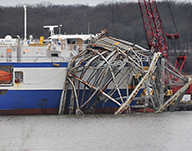
Austin Ramsey
News Editor
Portions of the 322-foot span of bridge draped over the Delta Mariner were removed over the weekend, giving the 2,800-ton freight ship enough room to move down river Monday.
The ship, which struck the Eggner’s Ferry Bridge over Kentucky Lake two weeks ago has sat dormant under the bridge since the incident, pending approval of a salvage plan by the ship’s owner Foss Maritime.
That plan came late last week and Kentucky Transportation Cabinet officials approved it immediately, making way for a maritime crane and several salvage dive crews to cut the underwater pieces of the bridge away from the ship beginning Saturday and finishing Monday, when the Delta Mariner was given U.S. Coast Guard approval to engine down the river to a shallow bay.
“The salvage operations are proceeding as planned, and it is a significant milestone that the ship has now been relocated downriver and clear of the Eggner’s Ferry Bridge,” Cmdr. Claudia Gelzer, of the Coast Guard Marine Safety Unit in Paducah, Ky., said.
Officials with the Land Between the Lakes National Recreation Area opened part of the U.S. 68/Ky. Hwy. 80 through the area east of the bridge Saturday to give locals the chance to see the bridge, ship and salvage operations first-hand.
Nicole Hawk, a media representative with LBL, said the protected national area provided the clearest and closest safe view of the bridge.
“There was a lot of public interest in seeing this area,” she said. “A lot of people use this bridge on a regular basis.”
Hawk said the area has experienced a slight decrease in visitors, and said she hoped the viewing time over the weekend would remind people that LBL is still in full operation, despite the closure of the bridge.
KTC officials spent the weekend working only a few hundred feet from salvage crews, as they are developing plans on how to restore the heavy bridge traffic.
A dive team assessed the bottom of the lake under the bridge and the piers on either side of the fallen span, following doubts that arose after the incident as to the stability of remaining portions.
Keith Todd, a spokesperson for the KTC, said more accurate tools were placed Tuesday to measure how much movement the bridge piers are experiencing (if any), including laser points placed on and off shore and surveying data collected along the bridges railing.
“We’re trying to provide as much information as possible, so when we do get to a point of being able to repair the bridge or whatever decision is made, we will have as much pre-engineering work done as possible,” he said. “So when we get to that point, we can move ahead fairly quickly.”
He said the KTC was evaluating six different restoration options, but would not say what those options were at present.
On Thursday, a KTC inspection team rappelled down four different piers of bridge to determine whether any exterior damage was caused where new portions of concrete were added to heighten the crossing for the expansion of the Tennessee River in the mid-1940s.
Todd said work is also underway to regain grid power to the bridge.
When it was struck, lighting for the entire structure went down with the bridge span, so KTC personnel have manned two generators on the Marshall County side of the bridge to power navigational lights.



























































































